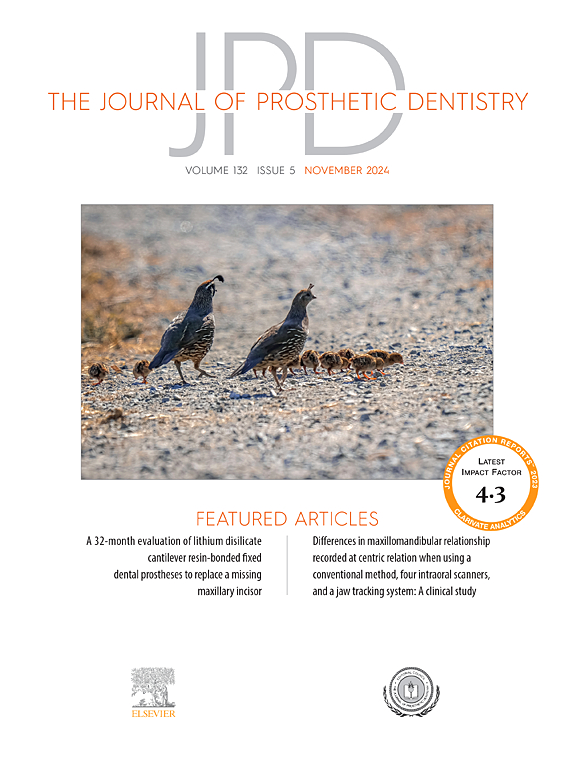Accuracy of an autonomous dental implant robotic system in dental implant surgery
IF 4.3
2区 医学
Q1 DENTISTRY, ORAL SURGERY & MEDICINE
引用次数: 0
Abstract
Statement of problem
Autonomous dental implant robot systems (ADIRSs) have been marketed for dental implant surgery; however, research on their accuracy is limited.
Purpose
The purpose of this clinical study was to examine the accuracy of an ADIRS.
Material and methods
Seventy-four participants with partial edentulism underwent implant surgery by using the ADIRS. Before surgery, a cone beam computed tomography (CBCT) scan was conducted, and its image data were fed into the ADIRS navigation and positioning system for iterative reconstruction and surgical path planning. After local anesthesia administration, area disinfection, and patient registration, the robot prepared the osteotomy and placed the implant under guidance of the navigation system. A postoperative CBCT scan was made to assess deviations between the planned and actual implant positions. The global coronal, apical, and angular deviations were measured and analyzed. A generalized linear mixed model (GLMM) was used to compare the differences in major outcome variables (α=.05).
Results
All implant procedures were successfully carried out without any complications during surgery. A total of 86 implants were placed in 74 participants. The mean ±standard deviation global coronal deviation, global apical deviation, and angular deviation was 0.61 ±0.20 mm (95% CI: 0.23 to 1.0 mm), 0.79 ±0.32 mm (95% CI: 0.17 to 1.41 mm), and 2.56 ±1.10 degrees (95% CI: 0.42 to 4.70 degrees), respectively. The findings from the GLMM revealed that the implant region (premolar, molar; maxilla, mandible; left, right), implant length, and surgeon did not significantly impact accuracy (P>.05).
Conclusions
ADIRS showed high accuracy for implant placement because of the control of angular deviation and axial errors. The implant region, implant length, and surgeon had no significant influence on the accuracy of implant placement. Nevertheless, more clinical studies are required to support evidence-based clinical outcomes.
自主牙科植入机器人系统在牙科植入手术中的准确性。
问题陈述:自主牙科植入机器人系统(ADIRS)已用于牙科植入手术,但对其准确性的研究却很有限。目的:本临床研究的目的是检查ADIRS的准确性:材料:74 名部分缺牙症患者使用 ADIRS 接受了种植手术。手术前进行锥形束计算机断层扫描(CBCT),并将其图像数据输入 ADIRS 导航定位系统进行迭代重建和手术路径规划。在进行局部麻醉、区域消毒和患者登记后,机器人在导航系统的引导下准备截骨并植入假体。术后进行了 CBCT 扫描,以评估计划种植体位置与实际种植体位置之间的偏差。测量并分析了整体冠状、根尖和角度偏差。采用广义线性混合模型(GLMM)比较主要结果变量的差异(α=.05):所有种植手术均顺利完成,手术过程中未出现任何并发症。74 名参与者共植入了 86 个种植体。全球冠状偏差、全球根尖偏差和角度偏差的平均值(±标准偏差)分别为 0.61 ±0.20 毫米(95% CI:0.23 至 1.0 毫米)、0.79 ±0.32 毫米(95% CI:0.17 至 1.41 毫米)和 2.56 ±1.10 度(95% CI:0.42 至 4.70 度)。GLMM 的结果显示,种植区域(前磨牙、臼齿;上颌骨、下颌骨;左侧、右侧)、种植体长度和外科医生对准确性没有显著影响(P>.05):ADIRS能控制角度偏差和轴向误差,因此显示出较高的种植体植入准确性。种植区域、种植体长度和外科医生对种植体植入的准确性没有明显影响。不过,还需要更多的临床研究来支持以证据为基础的临床结果。
本文章由计算机程序翻译,如有差异,请以英文原文为准。
求助全文
约1分钟内获得全文
求助全文
来源期刊

Journal of Prosthetic Dentistry
医学-牙科与口腔外科
CiteScore
7.00
自引率
13.00%
发文量
599
审稿时长
69 days
期刊介绍:
The Journal of Prosthetic Dentistry is the leading professional journal devoted exclusively to prosthetic and restorative dentistry. The Journal is the official publication for 24 leading U.S. international prosthodontic organizations. The monthly publication features timely, original peer-reviewed articles on the newest techniques, dental materials, and research findings. The Journal serves prosthodontists and dentists in advanced practice, and features color photos that illustrate many step-by-step procedures. The Journal of Prosthetic Dentistry is included in Index Medicus and CINAHL.
 求助内容:
求助内容: 应助结果提醒方式:
应助结果提醒方式:


